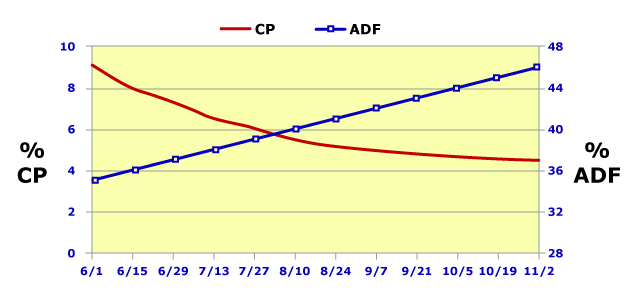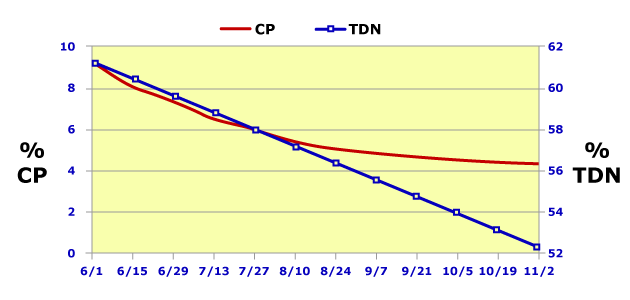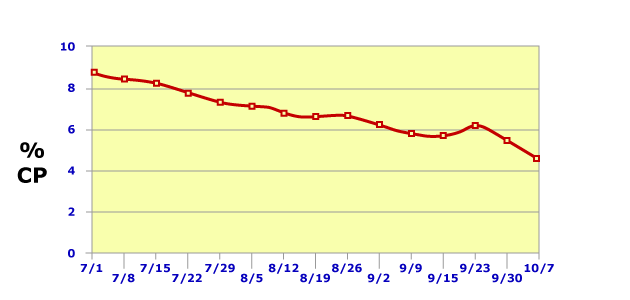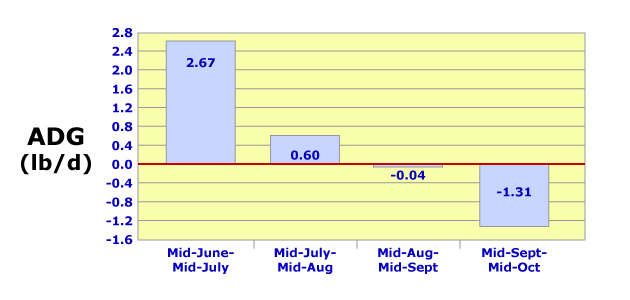Previous Page | Right click this page to print.
Forages
Beef producers rely primarily on forages for their nutrients. The majority of beef production in the U.S. and, for that matter, in the world is dependant upon forages. They are the primary source of energy, protein, and also many vitamins and minerals. In most cases, as with dairy cows, you are supplementing the forages you have. The forages are the foundation of the diet and if they are deficient, you supplement with either energy or protein sources to meet the nutrient requirements of the cow.
Why are forages important? We do have some beef produced from concentrate diets. However, as I said, the majority of beef produced in the U.S., and probably even more importantly worldwide, is through forage production.
Where does much of the import beef in the U.S. come from? It is from South American countries. What do you think Argentina relies primarily upon? Forage-based beef production. How could they possibly compete with the United States, when you consider its shipping costs and it is not cheap to ship something freight on a ship. How could they possibly compete with the U.S.? Cheap production of beef because they rely almost exclusively on forages.
As plants mature, forage quality decreases. What you typically see is a decrease in crude protein and TDN or total digestible nutrients. Fiber also increases. Remember, we use fiber as an estimate for intake. And ADF also increases and we use this for an estimate of digestibility. And so as forages mature, intake will decline, primarily because digestibility declines.
From this slide, I would like you to remember these top three lines and this is intake as a percent of body weight on low quality, medium quality and high quality forages.
% of BW |
|
|---|---|
Low Quality |
1.5-2.0 |
Medium Quality |
2.0-2.5 |
High Quality |
2.5-3.0 |
Spring Range |
2.4-2.9 |
Summer Range |
1.8-2.4 |
Fall Range |
1.7-2.2 |
| Winter Range |
1.4-1.8 |
At low quality, a cow can consume about one and a half to two percent of her body weight. On medium quality, two to two and a half. And when you get to high quality, about two and a half to three percent of her body weight. And look at how these correspond to range throughout the year, throughout the calendar year, so broken down into quarters. What would you say about spring range, what kind of quality is it? If you had to stick it into one of three categories you would say it is...High quality. What happens when you get into the summer? It starts to decline. So it is somewhere on the high end of medium quality, the low end of high quality. Fall range, you start to drop down into medium quality. And what about winter range? So what cows are grazing currently. Right. Very poor quality and so intake is very low in these animals. And so remember low quality one half to two percent, medium two to two and a half, and high quality two and a half to three percent.
These are the requirements for TDN and protein for a cow that is in mid-gestation, just prior to parturition, and then two different cows, one giving ten pounds of milk and one giving twenty pounds of milk.
% TDN |
%CP |
|
|---|---|---|
Mid-gestation |
44 |
6.3 |
60-90 days precalving |
48 |
7.0 |
Lactation (10 lbs) |
56 |
8.5 |
| Lactation (20
lbs) |
58 |
10.7 |
Nutrient requirements increase from mid-gestation to a cow giving twenty pounds of milk. TDN, the percent required in the diet, also increases, as does crude protein. Just keep in mind, mid 40s about 6% crude protein, high 50s about 10%.
We are going to look at some graphs of some range from Eastern Oregon.
This is the effect of maturity on crude protein and ADF as we go from June to November.

At what period during this could we meet the requirements for a cow producing 20 pounds of milk? TDN is not on this slide, but what about protein? She needs about 10.5%...10.7. What would the cow be experiencing June the 1st, a cow that’s giving 20 pounds of milk? What’s crude protein on this? 9%. So she is protein deficient at this point. The cow giving 10 pounds of milk, she required 8.5% and so she is still sufficient. Range to begin with is very low in protein, but as you go through the year, into the late fall, you get down to somewhere just slightly over 4%. What happens to ruminal fermentation when you get below 7% protein? It goes down. Mid to late June, intake at this point has been limited, not only by NDF, but by insufficient protein.
Remember the 10 and 20 pound cows, 56, 58, 8.5 and 10.7. What is most deficient, TDN or protein? Remember, the 20 pound cow needs 10.7 and 58% TDN.

Is TDN greater than 58 in early June? Yes. What about protein? No. If you put the early lactation cow, or excuse me the 20 pound, the 10 pound, the late gestation, in most cases TDN will be exceeded and crude protein will be deficient.
This is crude protein content of similar range from northeastern Oregon and Idaho.

This was from July the 1st to early October and what happened to crude protein content? From about 9% in July, down to somewhere around 5% in October. At what point would these animals be protein deficient, based on rumen ammonia needs? Remember it is about 7.5%, so somewhere in August they would be protein deficient. Remember the trend for TDN and crude protein, they are both going down as we progress through the summer and through the fall.
This is some data from the Union Station and these are cow gains broken down into two month intervals, or mid June to mid July, so this is one month intervals, mid July to August, August to September, September to October.

In mid June, mid July, cows were gaining about 2.7 pounds per day. By midsummer, it had dropped to about .6 pounds per day and by mid August to mid September, cows were losing weight. On this graph, where would you say they are in neutral energy balance, so they are not positive, they are not negative, they are just maintaining their weight? In August, they are pretty much maintaining their weight through mid August, mid September. As we get to mid September into October, the early fall, cows were losing about 1.3 pounds per day.
They also saw the same for calf gains. Go back to this.

So, if a cow is gaining, this quite a bit of weight per day, that means she is grazing some at least decent forage, right? Do you think she is giving any milk at this point versus a different point or if you compare the two? Probably more. If you look at calf gains, in the same monthly periods, mid June to mid July, calf gains were about 2.91. Now, were the calves doing anything else but suckling their mother? They were probably grazing some too, right? Remember, forage quality was much better in mid June to mid July. So not only was the cow giving some more milk, the calf was grazing some pretty good forage. When you go to mid July to August gains drop to 2.4, mid August to mid September 1.9, and by the fall they were down to about .8 pounds per day. Cows lost weight in those last two months. Calves gained, not as much. Why did the weight losses differ in the end? The cows lost weight and the calves just did not gain as much weight. Calves are still sucking their dams, right? The cows continue to consume lower and lower quality forage, she continues to produce milk, maybe not as much, but her energy expenditure is greater than her consumption.
There are some options for increased average daily gain during the grazing period. We will see probably some slides on, one is early weaning, one is supplementation either of the calves or the cows. Remove them from the summer range, so bring them back down to the meadows. Or we can creep feed the calves. Do you think this will affect cow condition if we take the calf off early, supplement the cow, creep feed the calf? All of these not only may improve weaning weights, or 205-day weights, but may also improve cow body condition score.
Earlier in the lecture, I mentioned that if crude protein is less than 7% of the diet, at this point, it is inadequate to maintain rumen function. So ammonia is deficient, the microbes do not breakdown the fiber as efficiently, passage rate declines, and so intake declines. So remember energy was, if you compare energy and protein, the relative deficiency of the two, protein was usually more deficient than energy. But, if you do not have enough protein to stimulate microbial fermentation, the energy in the forage is of little use.
Previous Page | Right click this page to print.